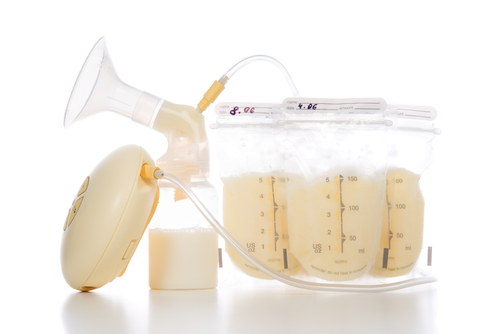Lesson 3: Infant family presence in the NICU
3.2 Establishing Milk Supply
 Furnishing human milk to preterm infants should be considered a fundamental component of their medical care. Although it cannot fully meet the nutrient needs of the preterm infant and requires fortification (covered in unit 3, lesson 3of this module), it does offer compelling non-nutritive benefits, including protective effects against infection and reduction in incidence of NEC. Human milk use in preterm infants is advocated by major health organizations including the World Health Organization, the American Academy of Pediatrics (AAP) and the European Society for Paediatric Gastroenterology, Hepatology and Nutrition (ESPGHAN).
Furnishing human milk to preterm infants should be considered a fundamental component of their medical care. Although it cannot fully meet the nutrient needs of the preterm infant and requires fortification (covered in unit 3, lesson 3of this module), it does offer compelling non-nutritive benefits, including protective effects against infection and reduction in incidence of NEC. Human milk use in preterm infants is advocated by major health organizations including the World Health Organization, the American Academy of Pediatrics (AAP) and the European Society for Paediatric Gastroenterology, Hepatology and Nutrition (ESPGHAN).
Providing preterm infants with human milk can be particularly challenging. Mothers of preterm infants may have given birth before even having decided whether to breastfeed or not. Many if not most of these infants are initially too small or weak to suckle. Some are quite ill, intensively monitored and on ventilatory support. Parents are often separated from their infants far more and far longer than after a term birth. Indeed, for some mothers with an infant in the NICU, supplying breast milk may end up seeming like one of the few things they can do for their baby.
In this video, four women talk about the experience of providing milk for their preterm babies.
NHS CHOICES VIDEO: Breastfeeding a pre-term baby
Source: NHS Choices 2014
 To promote the use of breast milk and breastfeeding in preterm infants, the neonatal intensive care unit staff must be available to counsel parents about the importance of human milk for a preterm infant and to help new mothers establish their milk supply. Commonly, it can take weeks or even months before a preterm infant can feed at the breast, but new mothers will need help to begin to hand-express and/or pump milk as soon as possible after delivery. The onset of lactogenesis II, when the milk "comes in,” appears delayed when delivery occurs prematurely (Henderson et al. 2008). Neonatal intensive care units must have appropriate rooms available for the mother to use while expressing milk by hand or with a pump. The first small amounts of colostrum are particularly important for the preterm infant.
To promote the use of breast milk and breastfeeding in preterm infants, the neonatal intensive care unit staff must be available to counsel parents about the importance of human milk for a preterm infant and to help new mothers establish their milk supply. Commonly, it can take weeks or even months before a preterm infant can feed at the breast, but new mothers will need help to begin to hand-express and/or pump milk as soon as possible after delivery. The onset of lactogenesis II, when the milk "comes in,” appears delayed when delivery occurs prematurely (Henderson et al. 2008). Neonatal intensive care units must have appropriate rooms available for the mother to use while expressing milk by hand or with a pump. The first small amounts of colostrum are particularly important for the preterm infant.
Lawrence & Lawrence make a number of recommendations for establishing milk supply in the mother of a preterm infant. These include initiation of milk expression or extraction as soon as possible; warming and gentle massage of the breasts prior to each pumping session; and regular use of a double breast pump for at least 5 pumping sessions totaling at least 100 minutes per day (Lawrence & Lawrence 2011). Pumping near one's baby can be helpful, ideally in a quiet, private, relaxing setting. Mothers should also make sure they have at least one 6 hour period of uninterrupted sleep per day.
Generally, frequent emptying of the breast leads to establishment of good milk supply and, conversely, infrequent emptying of the breast can result in poor milk supply. The individual mother's response to longer pauses between breast emptying varies. Pump-dependent mothers need to assess how sensitive their milk production is to longer intervals between pumping. Careful recording of daily pumping sessions and milk volumes is helpful to track changes as milk supply is being established.
Breast pumps can be manual or electric and single or double. The regular use of a double electric breast pump is generally preferred. Time is saved with use of a double pump. Moreover, use of a double pump may result in a higher prolactin level (and thus greater milk volumes) (Lawrence & Lawrence 2011). Some pumps have varied vacuum pressure settings that can mimic the pressure patterns of a suckling infant. Higher milk volumes can be produced when women massage their breasts during a double pumping session, a technique known as "hands-on pumping” (HOP) (Jones et al. 2001).
Techniques to improve initiation and maintenance of high levels of milk production in pump-dependent women of preterm infants are of great interest. Increased frequency of hand expression of colostrum in the first three postpartum days and pumping at least 7 times per 24 hours has been found to lead to higher milk volumes at two weeks postpartum (Morton et al. 2009). In addition, once milk supply has been established, thorough emptying of the breast appears more important for stimulating milk production than frequency of nursing or pumping. When 67 mothers of preterm infants were taught three techniques: breast compression prior to pumping, HOP, and using manual expression to remove milk remaining after pumping, Morton and colleagues found that at 8 weeks postpartum these mothers achieved milk volumes equal to or greater than those generally seen in breastfeeding mothers of term infants (Morton et al. 2009).
Very practical videos demonstrating hand expression of colostrum, "hands-on pumping” (breast massage during pumping) and hand expression of residual milk after pumping may be seen at Stanford School of Medicine 2015. ('Hand Expressing Milk' and 'Maximizing Milk Production'). (Note: videos contain images of breasts that may be deemed inappropriate for some individuals)
